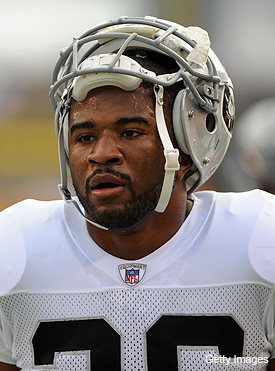 In Wednesday's Yahoo! NFL feature on Oakland Raiders cornerback Stanford Routt, I talked to Routt about the recent "Burn Rate" statistic used to designate which cornerbacks were most and least efficient though the 2010 season. The statistic, which divides receptions by targets, showed that Routt was the second-best cornerback in the league last season with 50 or more passes in his direction ? he allowed just 39 completions on 99 targets (39.4%) for 635 yards, five touchdowns, and 13 passes defensed.
In Wednesday's Yahoo! NFL feature on Oakland Raiders cornerback Stanford Routt, I talked to Routt about the recent "Burn Rate" statistic used to designate which cornerbacks were most and least efficient though the 2010 season. The statistic, which divides receptions by targets, showed that Routt was the second-best cornerback in the league last season with 50 or more passes in his direction ? he allowed just 39 completions on 99 targets (39.4%) for 635 yards, five touchdowns, and 13 passes defensed.
At least, that's what STATS, Inc. said. Routt had a different story to tell ? a story that would negate two of the touchdowns for which he was held responsible, remove 97 yards from his yardage allowed total, and but his Burn Rate at 37.4%. Revis would still be #1 at 33.9%, but Routt mentioned to me that two of his five alleged allowed touchdowns should not have been put on his name.
And as the film tends to show, those touchdown responsibilities aren't always so ? for Routt or any other cornerback in the league. I first learned this when former NFL quarterback Hugh Millen set me straight on a coverage mistake for which Seattle Seahawks safety Kam Chanellor was blamed and shouldn't have been.
With that in mind, I went back and watched the touchdown "credited" to Routt when the Raiders played the Tennessee Titans in Week 1. It was a 56-yard boot-action bomb from Vince Young to Nate Washington in which safety Tyvon Branch bit on the run fake, and Routt was left to scramble downfield when Washington went unobstructed over the top. The look appeared to be Cover-2, which requires the safety taking coverage over the top and the cornerback handing off the coverage downfield. It's a common coverage error for which cornerbacks are frequently blamed, even when they're not at fault.
The other touchdown in question happened against the San Diego Chargers in Week 5, a 41-yard bomb to Malcom Floyd. Routt told me what he recalled about the play: "That was a form of deep man ? and [Floyd] ran an over route from one side of field to the next." Routt didn't want to throw his teammates under the bus [these observations are mine, not his, as a result]. On the San Diego touchdown, it looked like a nickel set in which Routt covered Patrick Crayton until Crayton slanted inside at about the 10-yard mark. Coverage looked to be a reverse Cover-2, where the safety plays deep and the corner plays underneath, while Floyd sped downfield. Nnamdi Asomugha dropped into deep coverage, and safety Michael Huff was left to stand as the primary intermediate/deep defender on Crayton. Routt was blamed, it seems, simply because he was the player closest to Floyd when he crossed the goal line. Call me crazy, but I'm thinking that Routt shouldn't be dinged for doing his best to get downfield on a coverage responsibility that wasn't his. He was left holding the bag
We discussed the difficulty of designating pass coverage efficiency with mere metrics in our burn rate/stop rate series ? it is absolutely impossible to know who's responsible for what coverage unless you can watch the coach's tape, and even then, you're guessing because you don't have access to the game plan. That cornerback mistake in Cover-3 to your eyes may very well be a blown safety assignment in Cover-2. And what looks like man-on-man may be Cover-1 with a deep defender unable to take his eyes off the running back. That's the caveat we have to keep going back to when discussing pass coverage metrics beyond interceptions and passes defensed. and that's also the other side of this argument; Routt may have given up completions where the statistical bull's-eye wasn't on him.
Unless you're in the film room and the coaches are barking out assignments ? well, take it away, Mr. Mora ?
Stanford Routt would most likely agree.
Victoria Pratt Shakara Ledard Vanessa Marcil Rachel McAdams Kristin Cavallari
No comments:
Post a Comment